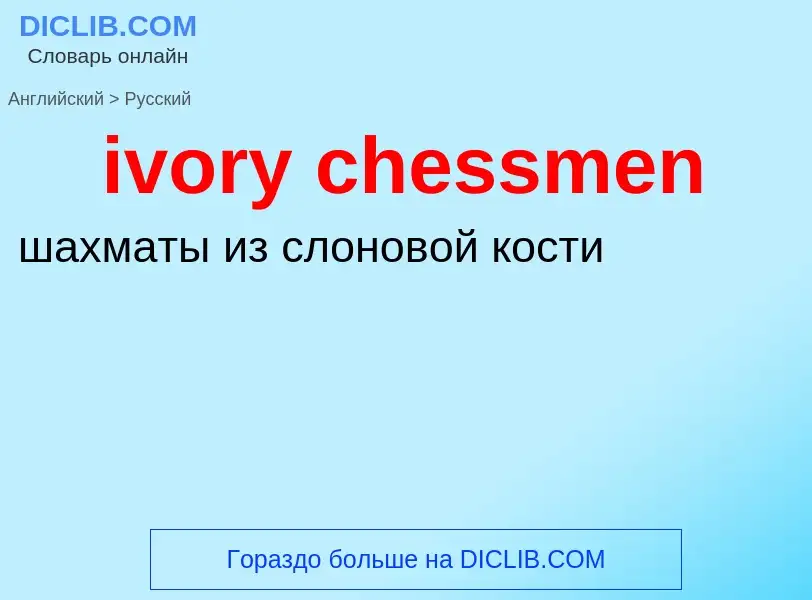Перевод и анализ слов искусственным интеллектом ChatGPT
На этой странице Вы можете получить подробный анализ слова или словосочетания, произведенный с помощью лучшей на сегодняшний день технологии искусственного интеллекта:
- как употребляется слово
- частота употребления
- используется оно чаще в устной или письменной речи
- варианты перевода слова
- примеры употребления (несколько фраз с переводом)
- этимология
ivory chessmen - перевод на русский
общая лексика
слоновая кость
Википедия

The Lewis chessmen (Norwegian: Lewisbrikkene; Scottish Gaelic: Fir-Tàilisg; Scots: Lewis chesmen) or Uig chessmen, named after the island or the bay where they were found, are a group of distinctive 12th-century chess pieces, along with other game pieces, most of which are carved from walrus ivory. Discovered in 1831 on Lewis in the Outer Hebrides of Scotland, they may constitute some of the few complete, surviving medieval chess sets, although it is not clear if a set as originally made can be assembled from the pieces. When found, the hoard contained 93 artifacts: 78 chess pieces, 14 tablemen and one belt buckle. Today, 82 pieces are owned and usually exhibited by the British Museum in London, and the remaining 11 are at the National Museum of Scotland in Edinburgh.
Additionally, a newly identified piece, a "warder", the equivalent of a castle or rook, was sold for £735,000 in July 2019. Four other major pieces, and many pawns, remain missing from the chess sets.










![Cylindrical ivory casket, Siculo-Arabic, [[Hunt Museum]]. Cylindrical ivory casket, Siculo-Arabic, [[Hunt Museum]].](https://commons.wikimedia.org/wiki/Special:FilePath/Cylindrical Ivory Casket.jpg?width=200)
![An ivory [[tabernacle]] featuring the Madonna of Caress, France An ivory [[tabernacle]] featuring the Madonna of Caress, France](https://commons.wikimedia.org/wiki/Special:FilePath/Ivory tabernacle Louvre OA2587.jpg?width=200)

![A depiction of the [[Blessed Virgin Mary]] and the [[Child Jesus]] crafted in elephant ivory A depiction of the [[Blessed Virgin Mary]] and the [[Child Jesus]] crafted in elephant ivory](https://commons.wikimedia.org/wiki/Special:FilePath/Vierge a l'Enfant debout.jpg?width=200)
![The Bull Leaper, an ivory figurine from the palace of [[Knossos]], [[Crete]], 1500 BC The Bull Leaper, an ivory figurine from the palace of [[Knossos]], [[Crete]], 1500 BC](https://commons.wikimedia.org/wiki/Special:FilePath/The Bull Leaper Knossos 1500BC.jpg?width=200)
![pyxis]] with griffins attacking stags. Late 15th century BC pyxis]] with griffins attacking stags. Late 15th century BC](https://commons.wikimedia.org/wiki/Special:FilePath/AGMA Ivory Pyxis with Griffins Attacking Stags.jpg?width=200)
![A piece of carved ivory from the Pushkin Museum representing [[Christ]] blessing Emperor [[Constantine VII]]. Mid 10th century AD A piece of carved ivory from the Pushkin Museum representing [[Christ]] blessing Emperor [[Constantine VII]]. Mid 10th century AD](https://commons.wikimedia.org/wiki/Special:FilePath/Porphyrogenetus.jpg?width=200)
![Ivory cover of the [[Codex Aureus of Lorsch]], c. 810, [[Carolingian dynasty]], [[Victoria and Albert Museum]] Ivory cover of the [[Codex Aureus of Lorsch]], c. 810, [[Carolingian dynasty]], [[Victoria and Albert Museum]]](https://commons.wikimedia.org/wiki/Special:FilePath/Ivory cover of the Lorsch Gospels, c. 810, Carolingian, Victoria and Albert Museum.jpg?width=200)
![[[Pig]] tusks [[Pig]] tusks](https://commons.wikimedia.org/wiki/Special:FilePath/BigUnTusks6184w.jpg?width=200)

![''Battle of Hannibal and Scipio (Alexander's victory over Poros)'', by [[Ignaz Elhafen]], c. 1700, [[Warsaw Royal Castle]] ''Battle of Hannibal and Scipio (Alexander's victory over Poros)'', by [[Ignaz Elhafen]], c. 1700, [[Warsaw Royal Castle]]](https://commons.wikimedia.org/wiki/Special:FilePath/Elhafen Battle of Hannibal and Scipio.jpg?width=200)
![Section through the ivory tusk of a [[mammoth]] Section through the ivory tusk of a [[mammoth]]](https://commons.wikimedia.org/wiki/Special:FilePath/Mammoth ivory hg.jpg?width=200)

.jpg?width=200)
![The ''[[Morgan Casket]]'', an 11th-century ivory casket attributed to Southern Italy, currently in the collection of the [[Metropolitan Museum of Art]] The ''[[Morgan Casket]]'', an 11th-century ivory casket attributed to Southern Italy, currently in the collection of the [[Metropolitan Museum of Art]]](https://commons.wikimedia.org/wiki/Special:FilePath/Morgan Casket MET DP100742.jpg?width=200)
![A cubical ivory bead or game piece from the collections of the [[Hunt Museum]] A cubical ivory bead or game piece from the collections of the [[Hunt Museum]]](https://commons.wikimedia.org/wiki/Special:FilePath/Ivory bead A.jpg?width=200)
![Murshidabad]], [[India]] Murshidabad]], [[India]]](https://commons.wikimedia.org/wiki/Special:FilePath/Royal Peacock Barge LACMA M.82.154.jpg?width=200)
![Ivory workers in [[Calcutta]], c. 1903 Ivory workers in [[Calcutta]], c. 1903](https://commons.wikimedia.org/wiki/Special:FilePath/Ivory workers in Calcutta (c. 1903).jpg?width=200)
